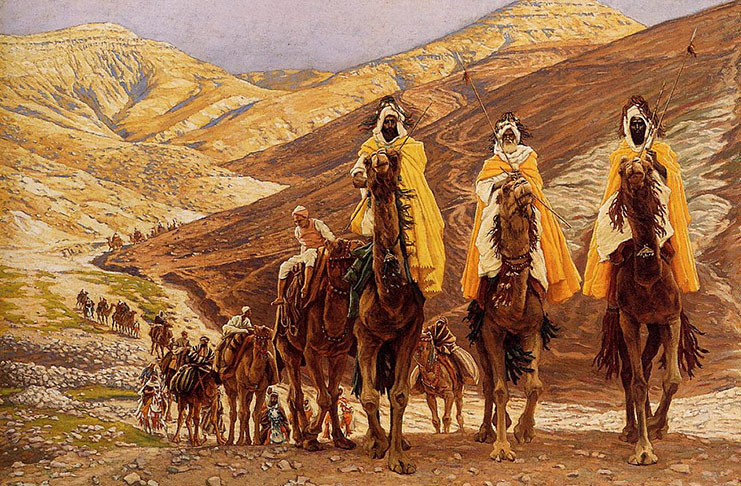FOR those unfamiliar with the subject, The Adoration of the Magi, in visual art it is the name typically given to the Nativity scene that features the three kings who followed the Star of Bethlehem to baby Jesus and his mother, Mary.
Following the procession and subsequent discovery of the newborn saviour, they laid before him gifts of gold, frankincense and myrrh to honour his arrival. In some cases, an ox or donkey is pictured in the scene and in other cases it’s not uncommon for Joseph to be pictured as well. Those details vary from artist to artist and sometimes the amount of “artistic freedom” taken is dependent on the period in which the artwork was created.
Last year I wrote about Albert Dürer’s interpretation of The Adoration of the Magi, one of the few interpretations I’ve come across that presents one of the three kings as someone of African descent. This year, however, I wanted to focus on the journey leading up to the “adoration,” as portrayed by the French painter James Tissot. While the “adoration” is usually the focus of paintings about this subject, the arrival of the Magi is often shown in the distant background of a Nativity scene or sometimes (as in this Tissot painting) a separate subject, the Journey of the Magi. In this case, they are presented as the most prominent figures in the picture plane, occupying about half of the width of the canvas, and it is implied that they are following the Star of Bethlehem since it’s not actually pictured.

Prior to the creation of this work, Tissot had made a successful career for himself painting the stylish leisured class of the late-nineteenth century. But it wasn’t until much later in his career that his more religious body of work, particularly illustrations of the life of Christ, became popular.
In fact, these works (estimated to number at around 700 in total) are considered his greatest achievement. Journey of the Magi, in particular, was created after Tissot’s second trip to the Middle East. He visited the region three times between the years 1886 and 1896, taking photographs and making sketches for a more accurate portrayal of this subject.
For him, this research component represented a crucial part of his creative process since it allowed him to study the people who lived there, the type of garments they wore and the unique topography, as well as the colour palette of the region. This alone, in my opinion, underscored his unwavering commitment as a creative practitioner to accurately representing both his subjects as well as their homeland.
Journey of the Magi emphasises the influence of photography on Tissot’s striking composition. His almost obsessive attention to detail is immediately evident. Tissot spares no detail in the rendering of the mountains, the figures and the animals in each plane (foreground, middle ground and background).
The shimmering, golden yellows; soft purples; and rich browns all work together to create a finished work of art that would encourage any viewer to spend hours marvelling at the mastery of his techniques. The interplay of highlights and shadows, his beautiful use of colours and his expertly structured composition, easily make this my favourite painting of this genre.
Tissot’s brilliant positioning of the Magi in this painting is successful in a number of ways: it creates the feeling that although they might be en route to baby Jesus, the Magi could also be approaching the viewer, almost moments away from stepping off the canvas entirely. If we close our eyes to the distractions of our current realities, we could certainly feel them brush past us, garments flowing behind as they do. This kind of cinematic quality proves yet again just how attuned he was to the photographic techniques of the time.
His treatment of each King is also interesting to observe. While he suggests different ages by the colour of their beards, these men are certainly not melanin-deficient. In fact, their dark faces are in stark contrast to their golden robes and, strange enough, are among the first observations of the painting that are typically made. And, although each King is presented on exactly the same plane with no clear indication of hierarchy, you do get the feeling that the central (and perhaps wiser) figure is flanked on either side by younger but equally important figures.
And of course, it would be remiss of me to neglect the camels, the only type of animal featured in this painting. They are many and they are indeed strong, having withstood the sweltering heat and intense dryness they would’ve no doubt experienced up to that point of their journey. It certainly would’ve been a difficult task but they were not painted in a manner to suggest that they were overwhelmed by either climate or cargo. The long trail of men on camels extends far beyond the mountain range and disappears into the distance, suggesting baby Jesus and his mother Mary were to expect quite a few visitors.
Having examined most of the qualities that elevate Journey of the Magi to the top spot in my book, I sincerely hope you enjoy this painting as much as I do! Regardless of your religion, if you celebrate the holiday or not, it is certainly a great time to spread love. Make a daily practice of it. With that said, all the best for the season and the New Year ahead!












